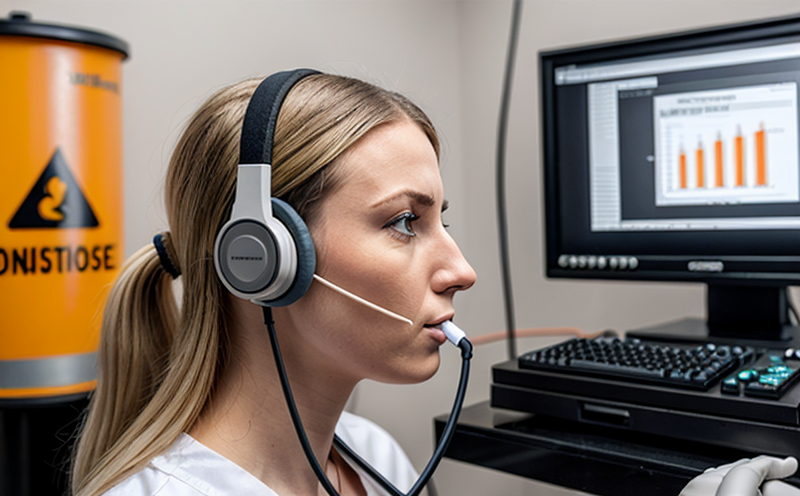Occupational Noise Exposure & Hearing Protection Testing
The Occupational Safety and Health Administration (OSHA) defines occupational noise exposure as a situation where an employee is exposed to sound levels that could potentially cause hearing damage or other adverse health effects. This service focuses on the testing methodologies used to evaluate both workplace noise levels and the effectiveness of hearing protection devices. Compliance with international standards such as ISO 1999:2012 and ANSI S3.45 ensures that organizations meet regulatory requirements and maintain a safe working environment.
The primary goal of this service is to ensure that employees are not exposed to harmful noise levels, which can lead to hearing impairment over time. The testing process involves multiple steps, including the measurement of sound intensity in decibels (dB), the evaluation of personal protective equipment (PPE) like earplugs and earmuffs, and the assessment of noise reduction ratings (NRR).
Sound is measured using a sound level meter that adheres to industry standards such as IEC 61672. The measurement points are strategically chosen based on OSHA's recommendations, which include areas where employees spend most of their time or where they perform tasks with the highest noise exposure levels. A typical workplace might have several different noise sources, and each source must be evaluated separately to ensure comprehensive coverage.
The testing process also includes a detailed analysis of hearing protection devices (HPD) provided by employers. The HPD are tested for their ability to block sound effectively at various frequencies using an ISO 4869-1:2005 compliant test method. This ensures that the PPE meets the required performance levels, as defined in ANSI S3.19 and EN 375 standards.
Once the noise exposure levels are determined and the HPD is tested, a comprehensive report is generated. The report includes detailed graphs of sound intensity measurements, comparisons with acceptable limits, and recommendations for improving workplace safety if necessary. This service also provides advice on selecting appropriate PPE based on specific job roles and environments.
The importance of this testing cannot be overstated in sectors like manufacturing, construction, and mining where high noise levels are common. Regular monitoring helps prevent long-term hearing damage among workers, thereby reducing healthcare costs and improving overall employee well-being.
| Industry | Noise Exposure Limits (dB) | Recommended Hearing Protection Devices |
|---|---|---|
| Mining | 90 dB (8 hours/day) | Earmuffs, Earplugs |
| Manufacturing | 85 dB (8 hours/day) | Hearing Protection Helmets |
| Construction | 90 dB (8 hours/day) | Earmuffs, Earplugs |
This service is crucial for ensuring that all organizations comply with OSHA regulations and maintain a safe working environment. By providing accurate noise exposure data and recommending suitable PPE, this testing ensures the well-being of employees while also protecting employers from potential legal issues.
Industry Applications
The following table highlights various industries where occupational noise exposure testing is critical:
| Industry | Description | Key Noise Sources |
|---|---|---|
| Mining | Extraction of minerals from the earth. | Mine drills, rock breakers, conveyors |
| Manufacturing | Production and processing of goods. | Machining equipment, stamping presses |
| Construction | Building structures and civil works. | Pile drivers, concrete mixers |
| Transportation | Travel by land, sea, or air. | Trucks, trains, airplanes |
In each of these industries, noise levels can be extremely high, posing significant risks to employee health. This service plays a vital role in mitigating those risks through precise measurement and evaluation techniques. The data collected is invaluable for making informed decisions about workplace safety measures.
Why Choose This Test
Selecting this test over others offers numerous advantages, particularly in terms of regulatory compliance and employee health. Compliance with international standards ensures that the testing process adheres to best practices recognized globally. Regular monitoring allows organizations to identify potential issues early on, preventing them from becoming serious problems later.
For quality managers and R&D engineers, this service provides valuable insights into how different factors affect noise levels within a facility. This information can be used to refine manufacturing processes or improve design iterations for machinery that generate less noise.
Compliance officers benefit greatly from having concrete evidence of compliance with OSHA standards, which reduces the risk of legal challenges and penalties associated with non-compliance. Additionally, it enhances the reputation of the organization as a responsible corporate citizen committed to employee welfare.
R&D engineers can leverage this service during product development stages to incorporate noise reduction features into new designs. By doing so, they contribute towards creating quieter workplaces which not only protect employees' hearing but also create more pleasant working environments overall.
Use Cases and Application Examples
Occupational noise exposure testing finds application across various scenarios:
Scenario 1: New Construction Site Setup
A newly established construction site might face challenges in determining appropriate PPE requirements due to varying noise levels. By conducting initial tests, safety managers can establish baseline data against which future measurements can be compared.
Scenario 2: Retrofitting Existing Facilities
An older manufacturing plant may have outdated equipment resulting in increased noise emissions. Regular testing helps determine the extent of this increase and informs decisions regarding upgrades or replacements.
Scenario 3: Introduction of New Machinery
The introduction of new machinery into a factory often leads to changes in ambient noise levels. Testing before installation allows for accurate assessment without disrupting production schedules.
Scenario 4: Periodic Audits
Regular audits help maintain continuous compliance with OSHA standards, ensuring ongoing safety and minimizing risks associated with non-compliance.
These scenarios demonstrate the versatility of occupational noise exposure testing in addressing diverse needs across multiple sectors. Its ability to provide actionable insights makes it an indispensable tool for maintaining a safe work environment.





